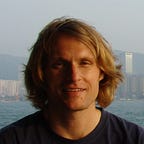TMA! Frank Lloyd Wright: The American Architect [S1:E1]
Video posted on May 15, 2015 (5–15–15) on YouTube.
I am lucky enough to live a few blocks away from a relatively unknown Frank Lloyd Wright building, one I self-identified on a visit to Santa Cruz, California, years ago. As we now live nearby, to get there from our house, we walk alongside a creek skillfully formed by the U.S. Army Corps of Engineers.
On the property, the virtues of the architect’s vision are apparent. The medical office complex hugs the edge of Branciforte Creek and is demure in scale. FLW’s trademark font is used at the entrance and on signage, while his favorite colors endure on every façade. The complex blurs the line between indoor and outdoor, creating legitimate magic when walking to the local doctor’s office. At center is a pharmacy, a bulls-eye floating in a black ocean paved in service to the car culture FLW worshipped.
Walking around, this complex also iterates the usual ills that dogged FLW’s career. First, everything is built for a human of small stature. Although 5’8”, FLW avoided specifying spaces adequately sized for a user like myself who is 6’2”. A literal headache. My daughter, at nearly 4’ tall, is of the perfect scale for enjoying this complex. Second, the joints of his buildings can be poor by design, seemingly an oversight, and many times are simply two glass planes meeting at 90–120 degree angle sealed with caulk. And most damning, the pleasantly demure roof lines do nothing if not guarantee resident rainwater buckets, ironic for a property known as 550 Water Street.
FLW was not just an architect, he was a hero of design mastery, fictionally described in Ayn Rand’s book, The Fountainhead, as a skinny-dipping, faithless, homely, red-headed design genius. In her own noted words, he was the noble soul par excellence. There are differing accounts of the interaction between Rand & FLW, but I know from other mere mortals that her adoration is characteristic of non-architects as he is recognized as an international superman of American design. Deserved or not, FLW’s power over our American vision of progress is probably best synthesized in the Marin Civic Center of San Rafael, California, a property a half-hour drive north of San Francisco.
Photographed extensively in the 1997 film Gattaca featuring Ethan Hawke, Uma Thurman & Jude Law, the Marin Civic Center has literally become an icon for Marin County. FLW died before construction, but as he delineated, the building suffers at times due to his common design faults. It is stuffy for even normal Americans of the 1960s, as here you can see a single escalator sized for a queue of teenage girls. In the hobbit-dimensioned atriums, questionable waterproofing details are evident. Many of the most important rooms, like the courts of the “Hall of Justice” are awkward, windowless and foreboding. In the mid-90s, an underground jail was added to the facility, a perfect complement to the round, draconian courts.
In spite of its limitations, the Marin Civic Center can be breathtaking, and perhaps for a wayward genetically inferior citizen of future America, the building itself can inspire one to venture to Saturn’s moon as portrayed in the Gattaca narrative.
